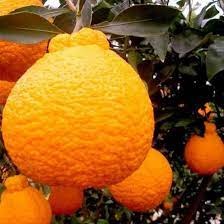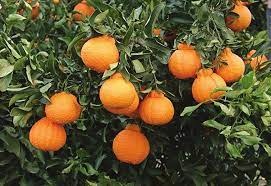Plantparadise
Dekopon Orange Plant
Dekopon Orange Plant
Couldn't load pickup availability
The Dekopon, also known as the Sumo Citrus or Shiranui, is a type of mandarin orange (Citrus reticulata) that is characterized by its large size, distinctive shape, and sweet flavor. Here's a brief plant description of the Dekopon orange:
Botanical Name: Citrus reticulata 'Dekopon' or Citrus reticulata 'Shiranui'
Plant Type: Fruit-bearing citrus tree
Origin: Dekopon oranges were first developed in Japan through crossbreeding various citrus varieties. They are now grown in different parts of the world, including the United States and Spain.
Growth Habit: Dekopon orange trees are medium-sized evergreen trees with a rounded canopy. They can reach a height of about 8-12 feet (2.4-3.7 meters) when mature.
Leaves: The leaves are glossy, dark green, and ovate in shape. They emit a pleasant citrus aroma when crushed.
Fruit: The Dekopon orange fruit is the highlight of this plant. It is large, often resembling the size of a small grapefruit. The fruit has a distinctive "topknot" or knob-like protrusion at the stem end, which is one of its identifying features. The skin is relatively easy to peel and is usually bright orange, sometimes with a slightly bumpy texture. The flesh is juicy, seedless (or nearly seedless), and has a rich, sweet flavor with a hint of tartness. The taste is often described as a combination of tangerine and orange, making it a popular choice among citrus enthusiasts.
Harvesting: Dekopon oranges are typically harvested in the winter months, from December to February, depending on the region. The fruit is carefully hand-picked to avoid damage.
Cultivation: Dekopon orange trees thrive in subtropical to Mediterranean climates. They require well-draining soil and full sunlight for optimal growth and fruit production. Regular watering and proper fertilization are essential to support healthy growth and fruit development. Pruning may be necessary to maintain the tree's shape and size.
Uses: Dekopon oranges are primarily grown for their delicious and unique-tasting fruit, which is often enjoyed fresh as a snack or used in culinary applications, such as desserts, salads, and beverages. The fruit's large size and attractive appearance also make it a popular choice for decorative purposes.
Materials
Materials
Shipping & Returns
Shipping & Returns
Dimensions
Dimensions
Care Instructions
Care Instructions








